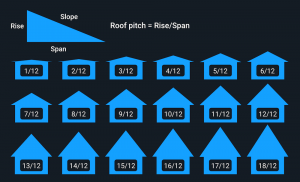
Yes, it can. The likelihood and level of severity depends on the time of year.
Shingles are hardy and are made to withstand an occasional walk. However, if it’s hot outside, say 80 degrees, and there’s direct sunlight on the roof, the asphalt base of the shingle will soften.
Walking over shingles that have softened in these conditions results in the granules to be displaced, and shoes with treads can even dig into the asphalt shingles resulting in premature failure. The softening is no big deal, that’s how asphalt works. But walking over them when they’re hot will cause damage.
Why would I need to get on my roof?
Many people don’t need to, or want to, get on their roof. Yet as a homeowner, there will likely come a time you’ll need to climb your ladder for one of the following reasons.
- Clean the gutters
- Check the flashing
- Trying to investigate a leak
- Fixing a satellite dish
- Get a cool picture of your backyard
Does the age of the shingles matter?
Yes, the age of the shingles matter. The older the shingles are, the more susceptible they become to damage from foot traffic. The granules begin to come off as the asphalt becomes brittle. The shingles may crack or break off when it’s cold, and could tear off during warm temperatures. This will typically be the case on shingle roofs over 25 years old.
How do I walk on a shingled roof?
- Wearing the Correct Shoes
Soft-soled shoes with larger surface-area tread should be used. Hiking boots and the like should be avoided, because these have more pointy, knobby styled treads which will more readily damage shingles. Tennis shoes, basketball shoes, and running shoes are usually a safe bet. These types of shoes actually provide better footing than hiking tread, so they are better for you and the roof!
The best times to get on your roof are in the spring and fall. Your roof shingles will not be as brittle as they are in colder months, while also not being as hot to the touch or as easily damaged as they are in warm summer months.
- Having the Right Equipment
You’ll need the correct tools and equipment to safely navigate your roof.
To start, you will need a ladder. You can set it against the gutters and use a bungee cord with hooks to secure the ladder. For the bungee cord, we typically use an EPDM tarp bungee strap.
Put on a pair of gloves while on the roof. Depending on the time of year, shingles could be hot to the touch. Gloves provide additional traction as they also protect your hands from getting scraped by the granules.
We recommend wearing long pants, such as jeans or cargo pants. Similar to the benefits of using gloves, the pants will protect your legs from the heat and abrasiveness of shingles.
An old foam cushion (foam from a sofa seat) can be used to traverse your roof safely. This material really sticks to shingles well, providing a better non-slip surface. Using this also helps minimize damage to the shingles.
 Consider the Pitch
Consider the Pitch
A pitch up to 6/12 can usually be walked on. Anything over this gets risky quickly. Pitch is calculated by determining how many inches of rise the roof has, relative to 12 inches of horizontal run, or distance. Think of a right-angled triangle. If the bottom horizontal line is 12” long, and the vertical line is 6” high, you have a 6/12 pitch roof.
- Walking to Ensure Traction
Once on the roof, stay leaned into the roof. If you’re walking up, you’ll be leaning forward and if you are descending the roof, you’ll be leaning backward. This will help keep your balance and allow your shoes to have maximum traction.
When descending the roof, you can also scale the roof going backwards, facing the roof and using your hands and feet to slowly go down. It will look like how to go up the roof, but backwards!
If your roof has a valley, you can straddle the valley having your right foot on the one plan of the roof and your left foot on the other. You’ll kind of waddle back and forth between feet to get up the roof.
Hire a Professional to Navigate your Roof
Alleviate your concerns by hiring a roofer to complete your work! At Joyland Roofing, our staff are trained with roofing best practices and OSHA requirements. We are excited for the opportunity to serve you!
Pennsylvania Home Improvement Contractor License (HIC) # PA124258

